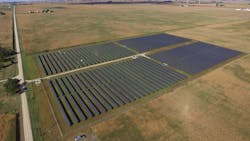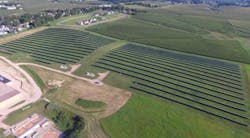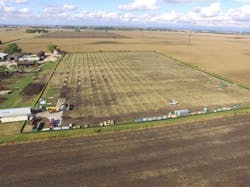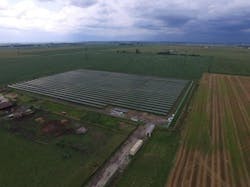Measuring the scope and impact of three new community solar projects developed by Summit Ridge Energy in ComEd’s northern Illinois region would seem to be a simple quantitative exercise.
Chicago-based ComEd, an Exelon company, powers the lives of more than 4 million residential and business customers, mostly in northern Illinois, from the Chicago metropolitan area to the Wisconsin border. The recently completed trio of solar arrays, occupying 46 acres in DeKalb County, encompasses over 15,000 solar panels and will generate 8.7 megawatts of renewable energy to meet the energy needs of up to 1,200 medium-sized homes. Customers who purchase renewable energy produced by the photovoltaic cells will lower their electric bills by up to 10 percent.
The Bigger Story
Peering behind the numbers of the three solar projects, which went into service in December of last year, reveals a bigger story. They are milestones on a remarkable trendline that points to a reduction in the use of fossil fuels and expansion of electrification. Increased adoption of solar energy, wind power and battery energy storage and growing EV adoption give customers more choices, which can put money back in their pocket. And continued grid modernization to enhance reliability in the face of extreme weather driven by climate change.
Just a few years ago, commercial-scale solar was virtually nonexistent in Illinois. Yet today, it has become one of the nation's fastest-growing markets for community solar – and the surge toward renewable energy is accelerating. This is partially driven by Illinois’ Climate and Equitable Jobs Act (CEJA), enacted in 2021, which puts the state on a path to 40% renewable energy by 2030 via a $350 million annual investment. To keep track with those goals, the state’s largest electric utility, ComEd, recently announced its support for a carbon-free energy future by the end of this decade.
All of which begs the question: how does a traditional electric utility that serves 70% of the population in a traditionally industrial region flip the switch to renewables – seemingly overnight? The answer, in a word, is partnership.
Partnering
Financial commitment and momentum notwithstanding, making the shift from traditional energy generation to renewables is still a heavy lift. There are many challenges to overcome: engineering, financing, regulatory requirements, supply chain and workforce considerations – even institutional inertia at times. By partnering with companies like Summit Ridge Energy, the largest commercial solar developer and owner-operator in Illinois, ComEd has grown its renewable energy capacity – interconnecting more than 105 community solar projects to its electric distribution system since 2019, of which nearly 40% are owned and operated by Summit Ridge.
There is a timeless proverb that says “if you want to go fast, go alone. If you want to go far, go together.” Long before breaking ground on the recently completed solar projects, ComEd and Summit Ridge had established an enduring and successful partnership that will make a major contribution to the renewable energy future in Illinois.
Challenges
Building a solar facility and connecting it to the grid is a complex process of planning, engineering studies (feasibility, system impact and facility), construction, connection, final inspection, signoff and, ultimately, operation. The process takes about a year. (Through collaboration and refinement, the timelines are getting shorter.) The nature of renewable projects, the costs, and stakes, are such that your partners need to be dependable. In the absence of mutual trust, things fall apart.
One of the more critical collaborations between an electric utility like ComEd and a solar developer like Summit Ridge is centered on finding optimal locations for connecting to the grid. For nearly five years, ComEd’s Distributed Energy Resource (DER) Engineering, Capacity Planning, and Interconnection teams have been developing methodologies to produce more accurate PV Hosting Capacity Maps.
Such information is increasingly important, as the growth of community solar relies heavily on identifying available locations that are well-suited for solar development. Avoiding locations that require considerable distribution system upgrades can significantly impact on the economic viability of prospective projects.
Developers like Summit Ridge can access the more frequently updated maps, which now provide a link to the queue data portal. Each substation and feeder where interconnections are proposed is identified by a unique index number reflecting the relative level of queue activity at various points on the distribution system.
“A hosting capacity map updated quarterly makes a considerable difference to developers compared to one updated annually, especially when you consider we received nearly 500 interconnection applications for community solar projects last year,” said Mark Baranek, senior vice president of Technical Services, ComEd. “Ultimately, we will publish the map monthly to provide developers with more timely and up-to-date information.”
“ComEd made significant enhancements to its solar hosting capacity map recently, a development that was well received by the solar development community,” said Mark Raeder, Principal at Summit Ridge. “Further enhancements like monthly updating will only increase the map’s usefulness in highlighting optimal areas to site our projects, which ultimately benefits both parties.”
In the quest to expand renewable energy, such arrangements are mutually beneficial. ComEd can meet government-mandated requirements for renewable energy – which are increasing – without incurring significant financial obligations required of capital-intensive energy generation projects. Moreover, they can guide developers to site projects in areas that may be beneficial to their grid. Developers, meanwhile, receive compensation from ComEd for the renewable energy credits generated by their projects, sell bill credits at a discount to any ComEd customer and benefit from renewable tax incentives. It’s a win-win.
Unexpected Benefits
Developers can be great resources for solving sticky engineering challenges for utilities like ComEd. On one occasion, Summit Ridge suggested tweaks to an inverter setting that solved a nagging engineering problem. This helped to ensure that the system would maintain proper voltage ranges when operating.
Every project is unique, and so are its challenges. The review of one such project concluded that it wouldn’t be financially feasible because of high interconnection costs. After multiple discussions among the parties, ComEd suggested that it may be possible to reduce the costs by implementing a newly tested Distributed Energy Resource Management System (DERMs). Summit Ridge successfully amended the original design and got the project over the finish line in cooperation with ComEd.
On the policy side of the equation, experienced commercial solar developers like Summit Ridge assist utilities by providing industry-based feedback on government policy proposals. Developers are well-positioned to help utilities understand the practical consequences of their proposed regulatory changes and vice versa.
ComEd works closely on long-term planning and investment in grid modernization and interconnection with renewable solar generation, enabling developers like Summit Ridge to site solar projects for maximum value and grid efficiency. In Illinois, this includes partnering to comply with the Illinois Power Agency's (IPA) Long-Term Renewable Resources Procurement Plan (LTRRPP), which authorizes more than $1.1 billion for new renewable generation in the state over a two-year period.
Looking Ahead
The future for solar energy in Illinois is bright. Through January of this year, there were 105 community solar projects in ComEd’s northern Illinois region, with an additional 40 Summit Ridge projects slated to come online before the end of 2024. Many of those projects will be focused on repurposing rooftops in the Chicago metropolitan area, a new focus for Summit Ridge in the region. As a result, ComEd’s customers can save money on their electric bills, while supporting the expansion of renewable energy and helping the state to attain its ambitious clean energy goals.
Summit Ridge and ComEd believe utility-developer partnerships will help secure a safe and reliable clean energy future. Policymakers, of course, play key roles in creating the incentives that are driving renewable energy development.
The Inflation Reduction Act is one of the most exciting things that has happened to energy and renewable energy generation in our lifetimes. In terms of renewable energy, it's the largest influx of investment seen to date. It is also one of the largest investments in grid modernization. Over the next 10 to 15 years, average Americans will feel the benefits from the growth in distributed generation through enhanced resiliency measures and increased grid reliability.
Partnerships between major utilities and commercial solar providers will be more important than ever. In the past six years, Summit Ridge Energy has invested more than $1.6 billion into clean energy assets. Its development pipeline includes more than 2 GW. By the end of 2024 Summit Ridge will have over 600 MW of PV online across the country, with 195 MW in ComEd’s northern Illinois territory.
In March, ComEd will file a new multi-year grid and rate plan with the Illinois Commerce Commission (ICC) that will support the rapid expansion of renewable energy in the state while furthering equitable access to clean energy benefits. The plan aligns with ComEd 2030, the company’s vision for a carbon-free energy future that will meet customers’ changing needs throughout the decade and beyond.
Mark Raeder is a co-founder of Summit Ridge Energy and serves as Principal, where he leads project origination and acquisition efforts in the Midwest region. In this capacity, Mark is involved in all aspects of the project development lifecycle, from policy-shaping efforts and market strategy to financial modeling, land acquisition and power sales. Previously, Mark was a senior consultant for SunEdison, where he performed financial, policy, and business development services.
About the Author
Mark Raeder
Mark Raeder is a co-founder of Summit Ridge Energy and serves as Principal, where he leads project origination and acquisition efforts in the Midwest region. In this capacity, Mark is involved in all aspects of the project development lifecycle, from policy-shaping efforts and market strategy to financial modeling, land acquisition and power sales. Previously, Mark was a senior consultant for SunEdison, where he performed financial, policy, and business development services.



